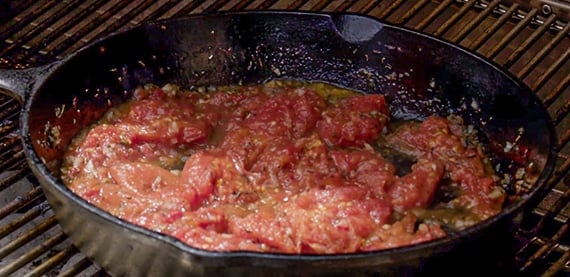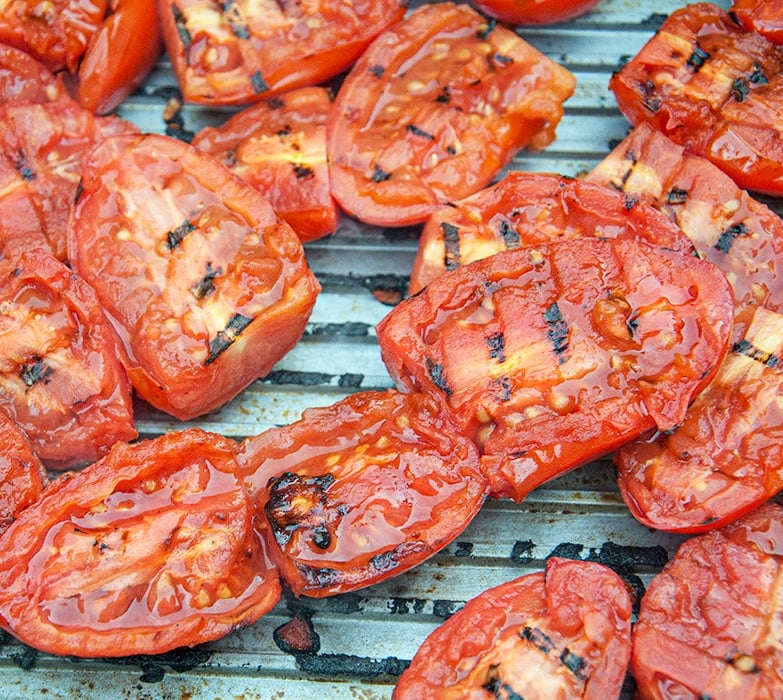Grilled tomatoes and vegetables are the key to what is arguably the best marinara sauce you’ve ever tasted
In August we are buried in tomatoes from our garden and we do everything except bathe in them. Even if you don’t have a garden, fresh ripe tomatoes are plentiful in late summer and early fall, and they are cheap and potent.
Get them from farmer’s markets where soft, ripe, dark red local tomatoes can be found. Grocery chains tend to buy underripe firmer tomatoes that can withstand shipping even when they are fully ripe in local gardens. Round tomatoes tend to be juicier, plum or egg shaped tomatoes tend to be meatier. Both work fine in this recipe. Don’t be afraid of cracked or scarred specimens. You can cut these parts out. Just avoid the bruised ones that have brown soft spots. Then again, sometimes you can get these on closeout and it is easy to cut out the bruises. You can put slightly green underripe fruits on a windowsill and they will ripen in a few days.
Marinara sauce is the great classic Italian tomato sauce from Naples (or maybe even from Spain, but don’t say this to Tony Soprano).
Marinara is the base sauce (or gravy as my Italian-American wife calls it) for many Mediterranean dishes. It is a “Mother Sauce” in that you can riff on it and make many other sauces. You can use it straight for pasta, or add meatballs, Italian sausage, or neckbones. Go wild and add a dollop of pesto or cream. Dose it with more oregano for pizza sauce. I even use it as a base for tomato soups.
The traditional Italian marinara is made entirely in a pan or pot. Guess where I start mine? Yes, you can grill or smoke the ingredients and really amp up the flavors and complexity.
It is so easy to make, and it freezes well, so there is no reason to ever buy it in a jar again. If you have a recipe that needs red sauce, you can make it a day or two in advance and keep it in the fridge.
So here’s how you have some fun with your friends. Invite them over to a “Grilled Spaghetti Dinner”, watch them scratch their heads, and serve them this incredible rich marinara sauce from the grill over pasta.
The Origin of Tomatoes
Historians tell us that tomatoes originated in South America and spread around the world after the Americas were invaded by the Spanish. Technically they are a fruit not a vegetable, they were at one time thought to be poisonous. Since then we have learned they are chock full of lycopene which researchers think is very good for us (today). They come is an endless variety of sizes and colors. Gardeners, farmers, and scientists have been cross breeding tomatoes for centuries seeking better flavor, higher yield, and disease resistance. There are a dozen very popular types in North America, among them Big Boys, Better Boys, Beefsteak, Romas, Grape, Cherry, and Campari. Greenhouse grown Camparis are available all year round, many of them from Ontario, and are very good. In the past decade gardeners have discovered “heirloom” tomatoes, older breeds that have interesting flavors and colors.
Makes:
Takes:
Ingredients
- 4 pounds ripe tomatoes
- 4 tablespoons inexpensive olive oil
- 1 small onion
- 1 carrot
- 2 stalks of celery, leaves removed
- 3 garlic cloves
- 1 bay leaf
- 1 ½ teaspoon Morton Coarse Kosher Salt
- ¼ teaspoon dried thyme
- ½ teaspoon dried basil
- ½ teaspoon dried oregano
- ½ teaspoon ground black pepper
Indoor version. I have made this dish successfully on a grill pan indoors. Not as good as outdoors, but better than the old saucepan standard.
These recipes were created in US Customary measurements and the conversion to metric is being done by calculations. They should be accurate, but it is possible there could be an error. If you find one, please let us know in the comments at the bottom of the page
Method
- Fire up. Preheat the grill to medium hot and when it is ready, clean the grates thoroughly. Clean grates are very important for this recipe. Get some smoke started by putting some dry wood chips on the heat source.
- Prep. Slice the tomatoes crosswise. Peel and slice the onion in half crosswise. Peel the carrot. Mince the garlic.
- Paint the cut sides of the tomatoes lightly with oil.
- Cook. Put the tomatoes on the grates in direct heat, cut end down for 5 to 10 minutes with the lid down or until they start to get some dark grill marks. Then roll them over and grill the skin side. Don’t worry if they blacken a bit on the skin side. Remove them and let them cool until you can handle them. While the tomatoes are cooling, put the onion, carrot, and celery on the grill and roll them around until well marked. The tomato skins should slip off pretty easily when they cool off enough so you can handle them. When the other veggies are cool, chop them fine.
- In a 2 quart (1.9 L) pot or large frying pan warm 2 tablespoons of olive oil over medium heat. Add everything except the tomatoes and cook about 10 minutes, stirring occasionally so they don't stick. If they stick you can deglaze the pan with a splash of red wine or water and by scrubbing the pan with a wooden spoon.
- Add the tomatoes to the pan, turn the heat to medium low, and simmer uncovered for about 1 hour. If it gets too thick add water.
- Serve. Remove the bay leaf, taste and adjust the seasonings. If it is too acidic, you can add up to 2 teaspoons of sugar to balance it. You're done. The result is lumpy with those flavorful fire roasted veggies, and that's just the way it is. If you don't like that, you can puree it in a blender or food processor or with a stick blender and strain it. Now pour your sauce over pasta, use it on pizza, in grilled eggplant parm, or on just about anything except ice cream.
- If you use it on pasta, a drizzle of really good fresh extra virgin olive oil on top gives it a nice boost. Or real Italian Parmigiano-Reggiano cheese. Or a heaping teaspoon of pesto, or 1/4 cup (60 mL) of cream, or 2 tablespoons of fresh chevre cheese, or meatballs, Italian sausage, or…




High quality websites are expensive to run. If you help us, we’ll pay you back bigtime with an ad-free experience and a lot of freebies!
Millions come to AmazingRibs.com every month for high quality tested recipes, tips on technique, science, mythbusting, product reviews, and inspiration. But it is expensive to run a website with more than 2,000 pages and we don’t have a big corporate partner to subsidize us.
Our most important source of sustenance is people who join our Pitmaster Club. But please don’t think of it as a donation. Members get MANY great benefits. We block all third-party ads, we give members free ebooks, magazines, interviews, webinars, more recipes, a monthly sweepstakes with prizes worth up to $2,000, discounts on products, and best of all a community of like-minded cooks free of flame wars. Click below to see all the benefits, take a free 30 day trial, and help keep this site alive.
Post comments and questions below
1) Please try the search box at the top of every page before you ask for help.
2) Try to post your question to the appropriate page.
3) Tell us everything we need to know to help such as the type of cooker and thermometer. Dial thermometers are often off by as much as 50°F so if you are not using a good digital thermometer we probably can’t help you with time and temp questions. Please read this article about thermometers.
4) If you are a member of the Pitmaster Club, your comments login is probably different.
5) Posts with links in them may not appear immediately.
Moderators